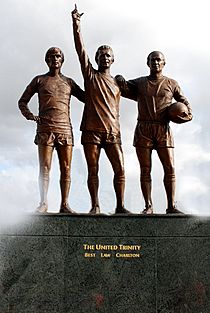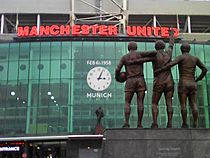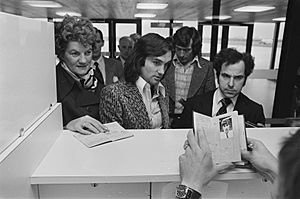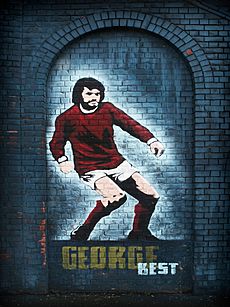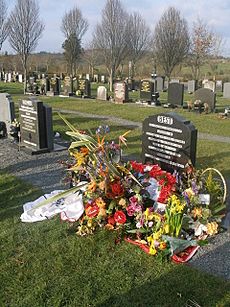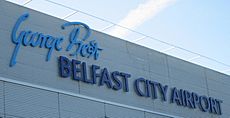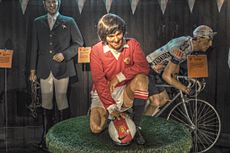George Best facts for kids
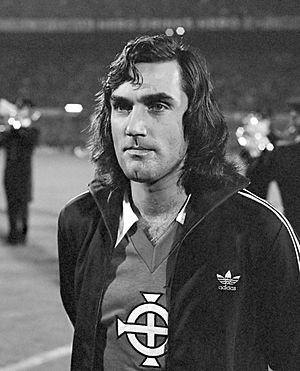
Best with Northern Ireland in 1976
|
|||
| Personal information | |||
|---|---|---|---|
| Full name | George Best | ||
| Date of birth | 22 May 1946 | ||
| Place of birth | Belfast, Northern Ireland | ||
| Date of death | 25 November 2005 (aged 59) | ||
| Place of death | South Kensington, London, England | ||
| Height | 5 ft 9 in (1.75 m) | ||
| Position(s) | Winger, attacking midfielder | ||
| Youth career | |||
| Cregagh Boys Club | |||
| 1961–1963 | Manchester United | ||
| Senior career* | |||
| Years | Team | Apps | (Gls) |
| 1963–1974 | Manchester United | 361 | (137) |
| 1974 | Dunstable Town | 0 | (0) |
| 1975 | Stockport County | 3 | (2) |
| 1975–1976 | Cork Celtic | 3 | (0) |
| 1976 | Los Angeles Aztecs | 23 | (15) |
| 1976–1977 | Fulham | 42 | (8) |
| 1977–1978 | Los Angeles Aztecs | 32 | (12) |
| 1978–1979 | Fort Lauderdale Strikers | 28 | (6) |
| 1979–1980 | Hibernian | 17 | (3) |
| 1980–1981 | San Jose Earthquakes | 56 | (21) |
| 1982–1983 | AFC Bournemouth | 5 | (0) |
| 1983 | Brisbane Lions | 4 | (0) |
| Total | 574 | (204) | |
| International career | |||
| 1964–1977 | Northern Ireland | 37 | (9) |
| *Club domestic league appearances and goals | |||
George Best (born 22 May 1946 – died 25 November 2005) was a famous Northern Irish footballer. He played as a winger, mostly for Manchester United. Best was known for his amazing dribbling skills. Many people think he was one of the greatest players ever.
In 1968, he was named European Footballer of the Year. He also came fifth in a vote for the FIFA Player of the Century. Best's playing style was exciting. He had speed, skill, balance, and could score goals with both feet. He was great at getting past defenders.
Born in Belfast, Best started his career in England with Manchester United. A scout saw him at 15 and sent a telegram to manager Matt Busby saying: "I think I've found you a genius." He played his first game at 17. Over 11 years, he scored 179 goals in 470 games. He was Manchester United's top scorer in the league for five years in a row. He helped the club win two League titles and the European Cup.
His exciting play made him a public favorite. In 1999, he was a finalist for the BBC's Sports Personality of the Century. In 2002, he was one of the first players to join the English Football Hall of Fame.
For his country, Best played 37 times for Northern Ireland between 1964 and 1977. He never played in a major tournament like the World Cup. This was because of his team's performance and his fitness later on. He is seen as one of the best players never to have played in a World Cup. The Irish Football Association called him the "greatest player to ever pull on the green shirt of Northern Ireland."
Best was also famous for his looks and lifestyle. Portuguese reporters called him "o Beatle" (the Fifth Beatle) after a great game in Lisbon in 1966. He became one of the first celebrity footballers. After his playing career, he worked as a football analyst. He faced health challenges later in life and passed away in 2005 at 59. This was due to complications from a liver transplant he had in 2002.
Contents
Early Life and Family

George Best was the first child of Richard "Dickie" Best and Anne Withers. He was born on 22 May 1946. He grew up in Cregagh, east Belfast. Best had four sisters, Carol, Barbara, Julie, and Grace, and one brother, Ian.
His mother, Anne, passed away in 1978 at 55. His father, Richard, passed away in 2008 at 88.
In 1957, George went to Grosvenor High School. However, he often missed school because the school focused on rugby union. Best then moved to Lisnasharragh Secondary School. This allowed him to play football with his friends. He played for Cregagh Boys Club. He supported Glentoran and Wolverhampton Wanderers.
Club Career Highlights
Joining Manchester United
When he was 15, Manchester United scout Bob Bishop found Best in Belfast. Bishop sent a telegram to manager Matt Busby saying: "I think I've found you a genius." Best's local club, Glentoran, had said he was "too small and light." United's chief scout, Joe Armstrong, then signed him.
At first, Best missed home and returned to Northern Ireland after two days. He came back to Manchester and spent two years as an amateur player. English clubs could not sign Northern Irish players as apprentices then. He worked as an errand boy. This allowed him to train with the club twice a week.
Best played his first game for the senior team at 17. It was on 14 September 1963 against West Bromwich Albion. United won 1–0. He scored his first goal in his second game on 28 December. United beat Burnley 5–1. Manager Matt Busby kept Best in the team after that. By the end of the 1963–64 season, he had played 26 games and scored six goals. Manchester United finished second in the league.
Best helped Manchester United win the league title in the 1964–65 season. He scored 14 goals in 59 games that year. He also scored the first goal in the 1965 FA Charity Shield, which ended in a 2–2 draw.
Best became a superstar at 19. He scored two goals in a European Cup quarter-final against Benfica in 1966. His amazing performance led the Portuguese media to call him "O Quinto Beatle" ("the fifth Beatle"). His talent and exciting play made him very popular. He became famous not just in sports news but everywhere.
United won the league title again in the 1966–67 season. Best scored 10 goals in 45 games. He then helped United share the Charity Shield with Tottenham Hotspur. This game was the first to be shown in colour on British TV.
European Cup Victory
The 1967–68 season was special for United fans. They won the European Cup. Best scored the only goal in the semi-final against Real Madrid. He was the league's top scorer that season with 28 goals.
Days later, Best won the FWA Footballer of the Year award. He was the youngest player to ever win it. In the European Cup Final at Wembley, United faced Benfica. Best scored a brilliant goal in extra-time. He beat the goalkeeper with a trick and rolled the ball into the net. United won 4–1. This victory was a high point for Best and Manchester United. It was especially meaningful because of the Munich air disaster ten years earlier.
Best also won the Ballon d'Or in 1968. He received more votes than Bobby Charlton and Franz Beckenbauer. By 22, he had won the league title, European Cup, and European Player of the Year.
The famous trio of Best, Law, and Charlton continued to play well. However, new players at the club were not as strong. United dropped to 11th in the league. Best felt he was "carrying the team at times." He scored 22 goals in 55 games. United reached the semi-finals of the European Cup but lost to A.C. Milan.
"It's been a joke on the circuit ever since. You know, I'm on one side of the street, George Best is on the other. He nods to me and I dive under a bus."
United finished eighth in the 1969–70 season. Best scored 23 goals. This included a record six goals in an 8–2 win over Northampton Town. One of his goals was particularly famous. He tricked the goalkeeper, Kim Book, and walked the ball into the net. This performance was voted No. 26 on a list of the 100 Greatest Sporting Moments.
Best started to face disciplinary issues. He was fined for misconduct. He was also suspended by United for missing training. New manager Frank O'Farrell led United to an eighth-place finish in 1971–72. Best scored hat-tricks against West Ham United and Southampton. He also scored a goal against Sheffield United after beating four defenders. He was sent off in a game against Chelsea. Best was the club's top scorer for the sixth season in a row. He scored 27 goals in 54 games.
United's performance continued to decline. Best was part of a group of older players who did not connect well with newer, less experienced players. Best missed training in December. He was suspended and put on the transfer list for £300,000. After Tommy Docherty became manager, Best announced his retirement for a second time.
Best's last game for United was on 1 January 1974. United lost 3–0 to Queens Park Rangers. He missed training again and was dropped by Docherty. United was later relegated to the Second Division.
Best played 470 games for Manchester United from 1963 to 1974. He scored 179 goals. After leaving United, he played for several other clubs. These included teams in South Africa, Ireland, the United States, Scotland, and Australia.
Later Club Years
Best played five games for Jewish Guild in South Africa. In 1975, he played three games for Stockport County. He also had a short time at Cork Celtic in Ireland. He played three league games there.
He had a good period with Second Division club Fulham in 1976–77. He showed he still had his skills, even if he was a bit slower. He played alongside Bobby Moore, a World Cup winning captain.
Best played for three clubs in the United States: Los Angeles Aztecs, Fort Lauderdale Strikers, and San Jose Earthquakes. He was successful on the field. He scored 15 goals in 24 games in his first season with the Aztecs. He was named the NASL's best midfielder in his second season.
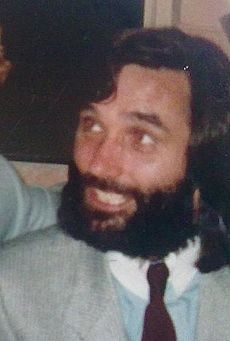
Best also played for the Scottish club Hibernian. He helped increase attendance at their games. One time, he was briefly let go by Hibs after missing a team event. But he was brought back a week later.
In 1982, he played 20 minutes for a small club called Scone Thistle. The money he received helped him pay a tax bill. He returned to the US to play for the San Jose Earthquakes. He also played for two teams in Hong Kong.
In late 1982, AFC Bournemouth signed the 36-year-old Best. He played for them until the end of the 1982–83 season. He retired from professional football at 37. He played a friendly game for Newry Town. He ended his career with a short time playing for the Brisbane Lions in Australia in 1983.
On 8 August 1988, a special match was held for Best at Windsor Park. Many famous players and coaches attended. Best scored two goals in the match.
International Career
Best played 37 times for Northern Ireland. He scored nine goals. Four of his goals were against Cyprus. He also scored against Albania, England, Scotland, Switzerland, and Turkey.
Best played with less pressure for Northern Ireland than for his club. He saw his international career as "recreational football." He is considered one of the greatest players who never played in a World Cup. Like George Weah, he played for a smaller football nation.
On 15 May 1971, Best scored a very famous "goal" against England in Belfast. English goalkeeper Gordon Banks threw the ball up to kick it. Best quickly kicked the ball first, sending it over Banks' head towards the empty goal. Best ran past Banks and headed the ball into the net. However, the referee did not allow the goal.
Best continued to play for Northern Ireland in the 1970s. Dutch captain Johan Cruyff said: "What he [Best] had was unique, you can't coach it." Best was briefly considered for the 1982 World Cup. But at 35, his skills were not as sharp, and he had not played for Northern Ireland in five years. He was not chosen for the squad.
Playing Style
Best was a very skilled winger. Many experts believe he was one of the greatest dribblers ever. People admired his playing style. It combined speed, skill, balance, tricks, and the ability to use both feet. He was excellent at getting past defenders.
Sports writer Patrick Barclay said: "In terms of ability he was the world's best footballer of all time. He could do almost anything – technically, speed, complete mastery of not only the ball but his own body. You could saw his legs away and he still wouldn't fall because his balance was uncanny, almost supernatural."
Best was known for his dribbling. But he also received praise for creating chances for others. A fan remembered seeing Best play in New Zealand. He said Best "evaded every player... until he reached the opposite end of the pitch and produced a perfectly floated centre for Charlton's head." He added that Best's "grace, agility and ball skills were only eclipsed by his unselfish passing."
Alex Stepney, a Manchester United goalkeeper, described one of Best's unique tricks. "Best would knock the ball on to the goalkeeper's shin... and the ball would bounce back to him and he would score. No one has been able to emulate that in football." He even did this against Liverpool at Anfield.
Personal Life and Legacy
In his early years at Old Trafford, Best was a quiet teenager. He spent his free time playing snooker. Later, he became known for his long hair and celebrity lifestyle. He even appeared on the TV show Top of the Pops in 1965.
He opened a nightclub called Slack Alice in Manchester in 1973. He also owned restaurants and fashion boutiques. Best's cousin, Gary Reid, passed away in 1974 during a period of unrest in Belfast.
Best married Angela MacDonald-Janes in 1978 in Las Vegas. They met when Best was playing for the Los Angeles Aztecs. Their son, Calum, was born in 1981. They separated in 1982 and divorced in 1986.
He married Alex Pursey in 1995. They divorced in 2004.
At the height of his career, Best appeared in advertisements. He promoted Cookstown sausages on television. He also advertised eggs with the slogan "E for B and Georgie Best."
Best had a small role as himself in the 1971 film Percy. In 1984, he made a fitness album called Shape Up and Dance. A biographical film called Best was released in 2000. John Lynch played George Best. The band The Wedding Present named their first album George Best.
Best earned a lot of money during his career. When asked what happened to his money, Best famously joked: "I spent a lot of money on birds (women) and fast cars. The rest I just squandered."
In 2012, Best was included in The New Elizabethans list. This recognized people who had a big impact on the UK during Queen Elizabeth II's reign.
Death and Memorials

George Best passed away on 25 November 2005, at 59 years old. He was in the Cromwell Hospital in London. His death was due to complications from his liver transplant in 2002. Many famous football players paid tribute to Best. These included Pelé, Diego Maradona, and Johan Cruyff. Maradona said: "George inspired me when I was young. He was flamboyant and exciting."
The Premier League held a minute of silence before all games that weekend. At many stadiums, fans chose to applaud instead. The first game at Old Trafford after his death was a League Cup match. Best's son, Calum, and former teammates joined the current United squad on the pitch. Fans held up pictures of Best during a minute of silence.
Funeral Service
Best's funeral was held on 3 December 2005, in Belfast. His body was taken from his family home to Stormont. About 100,000 mourners lined the route. Former Northern Ireland manager Billy Bingham and teammates carried the coffin.
A service was held in the Grand Hall. About 300 guests attended, and 25,000 mourners watched outside. The funeral was shown live on television. Best was buried next to his mother at Roselawn Cemetery. This cemetery overlooks east Belfast.
Tributes and Honors
Belfast City Airport was renamed George Best Belfast City Airport in his honor. The new name was unveiled on 22 May 2006, which would have been his 60th birthday.
In March 2006, the airline Flybe named a plane The George Best. This aircraft later carried Best's family to his memorial service in Manchester.
In June 2006, Sarah Fabergé created the George Best Egg as a tribute. Profits from the eggs went to the George Best Foundation. This foundation promotes health through sports. For the first anniversary of his death, Ulster Bank released special £5 notes. They sold out quickly.
In December 2006, a trust started raising money for a life-size bronze statue of George Best. A local developer, Doug Elliott, later provided the remaining funds.
Career Statistics
Club Appearances
| Club | Season | League | Cup | League Cup | Continental | Other | Total | |||||||
|---|---|---|---|---|---|---|---|---|---|---|---|---|---|---|
| Division | Apps | Goals | Apps | Goals | Apps | Goals | Apps | Goals | Apps | Goals | Apps | Goals | ||
| Manchester United | 1963–64 | First Division | 17 | 4 | 7 | 2 | — | 2 | 0 | 0 | 0 | 26 | 6 | |
| 1964–65 | First Division | 41 | 10 | 7 | 2 | — | 11 | 2 | 0 | 0 | 59 | 14 | ||
| 1965–66 | First Division | 31 | 9 | 5 | 3 | — | 6 | 4 | 1 | 1 | 43 | 17 | ||
| 1966–67 | First Division | 42 | 10 | 2 | 0 | 1 | 0 | — | 0 | 0 | 45 | 10 | ||
| 1967–68 | First Division | 41 | 28 | 2 | 1 | — | 9 | 3 | 1 | 0 | 53 | 32 | ||
| 1968–69 | First Division | 41 | 19 | 6 | 1 | — | 6 | 2 | 2 | 0 | 55 | 22 | ||
| 1969–70 | First Division | 37 | 15 | 8 | 6 | 8 | 2 | — | 0 | 0 | 53 | 23 | ||
| 1970–71 | First Division | 40 | 18 | 2 | 1 | 6 | 2 | — | 0 | 0 | 48 | 21 | ||
| 1971–72 | First Division | 40 | 18 | 7 | 5 | 6 | 3 | — | 0 | 0 | 53 | 26 | ||
| 1972–73 | First Division | 19 | 4 | 0 | 0 | 4 | 2 | — | 0 | 0 | 23 | 6 | ||
| 1973–74 | First Division | 12 | 2 | 0 | 0 | 0 | 0 | — | 0 | 0 | 12 | 2 | ||
| Total | 361 | 137 | 46 | 21 | 25 | 9 | 34 | 11 | 4 | 1 | 470 | 179 | ||
| Dunstable Town | 1974–75 | Southern League Division One North | 0 | 0 | 0 | 0 | 0 | 0 | — | — | 0 | 0 | ||
| Stockport County | 1975–76 | Fourth Division | 3 | 2 | 0 | 0 | 0 | 0 | — | — | 3 | 2 | ||
| Cork Celtic | 1975–76 | League of Ireland | 3 | 0 | 0 | 0 | 0 | 0 | — | — | 3 | 0 | ||
| Los Angeles Aztecs | 1976 | North American Soccer League | 23 | 15 | — | — | — | 1 | 0 | 24 | 15 | |||
| Fulham | 1976–77 | Second Division | 32 | 6 | 2 | 0 | 3 | 2 | — | — | 37 | 8 | ||
| 1977–78 | Second Division | 10 | 2 | 0 | 0 | 0 | 0 | — | — | 10 | 2 | |||
| Total | 42 | 8 | 2 | 0 | 3 | 2 | — | — | 47 | 10 | ||||
| Los Angeles Aztecs | 1977 | North American Soccer League | 20 | 11 | — | — | — | 5 | 2 | 25 | 13 | |||
| 1978 | North American Soccer League | 12 | 1 | — | — | — | — | 12 | 1 | |||||
| Total | 32 | 12 | — | — | — | 5 | 2 | 37 | 14 | |||||
| Fort Lauderdale Strikers | 1978 | North American Soccer League | 9 | 4 | — | — | — | 5 | 1 | 14 | 5 | |||
| 1979 | North American Soccer League | 19 | 2 | — | — | — | — | 19 | 2 | |||||
| Total | 28 | 6 | — | — | — | 5 | 1 | 33 | 7 | |||||
| Hibernian | 1979–80 | Scottish Premier Division | 13 | 3 | 3 | 0 | 0 | 0 | — | — | 16 | 3 | ||
| 1980–81 | Scottish First Division | 4 | 0 | 0 | 0 | 2 | 0 | — | — | 6 | 0 | |||
| Total | 17 | 3 | 3 | 0 | 2 | 0 | — | — | 22 | 3 | ||||
| San Jose Earthquakes | 1980 | North American Soccer League | 26 | 8 | — | — | — | — | 26 | 8 | ||||
| 1981 | North American Soccer League | 30 | 13 | — | — | — | — | 30 | 13 | |||||
| Total | 56 | 21 | — | — | — | — | 56 | 21 | ||||||
| AFC Bournemouth | 1982–83 | Third Division | 5 | 0 | 0 | 0 | 0 | 0 | — | — | 5 | 0 | ||
| Brisbane Lions | 1983 | National Soccer League | 4 | 0 | 0 | 0 | — | — | — | 4 | 0 | |||
| Career total | 574 | 204 | 52 | 21 | 30 | 11 | 34 | 11 | 19 | 6 | 705 | 251 | ||
International Appearances
| National team | Year | Apps | Goals |
|---|---|---|---|
| Northern Ireland | 1964 | 6 | 2 |
| 1965 | 6 | 1 | |
| 1966 | 1 | 0 | |
| 1967 | 1 | 0 | |
| 1968 | 1 | 1 | |
| 1969 | 4 | 0 | |
| 1970 | 4 | 1 | |
| 1971 | 6 | 4 | |
| 1972 | 2 | 0 | |
| 1973 | 1 | 0 | |
| 1974 | 0 | 0 | |
| 1975 | 0 | 0 | |
| 1976 | 2 | 0 | |
| 1977 | 3 | 0 | |
| Total | 37 | 9 | |
- Scores and results list Northern Ireland's goal tally first, score column indicates score after each Best goal.
| No. | Date | Venue | Opponent | Score | Result | Competition |
|---|---|---|---|---|---|---|
| 1 | 14 November 1964 | Stade Olympique de la Pontaise, Lausanne, Switzerland | 1–0 | 1–2 | 1966 FIFA World Cup qualification | |
| 2 | 25 November 1964 | Hampden Park, Glasgow, Scotland | 1–0 | 2–3 | 1964–65 British Home Championship | |
| 3 | 7 May 1965 | Windsor Park, Belfast, Northern Ireland | 4–1 | 4–1 | 1966 FIFA World Cup qualification | |
| 4 | 23 October 1968 | Windsor Park, Belfast, Northern Ireland | 1–1 | 4–1 | 1970 FIFA World Cup qualification | |
| 5 | 21 April 1970 | Wembley Stadium, London, England | 1–1 | 1–3 | 1969–70 British Home Championship | |
| 6 | 3 February 1971 | GSP Stadium, Nicosia, Cyprus | 3–0 | 3–0 | UEFA Euro 1972 qualification | |
| 7 | 21 April 1971 | Windsor Park, Belfast, Northern Ireland | 2–0 | 5–0 | UEFA Euro 1972 qualification | |
| 8 | 3–0 | |||||
| 9 | 4–0 |
Honours and Awards
Manchester United
- Football League First Division: 1964–65, 1966–67
- Charity Shield: 1965, 1967
- European Cup: 1968
Hibernian F.C.
- East of Scotland Shield: 1979–80
Individual Awards
- Football League First Division top scorer: 1967–68
- FWA Footballer of the Year: 1967–68
- Ballon d'Or: 1968; third place 1971
- PFA Team of the Year Second Division: 1977
- Football League 100 Legends: 1998
- Honorary doctorate from Queen's University Belfast: 2001
- Freeman of Castlereagh: 2002
- Inaugural inductee into the English Football Hall of Fame: 2002
- BBC Sports Personality of the Year Lifetime Achievement Award: 2002
- UEFA Jubilee Awards – Northern Ireland's Golden Player: 2003
- UEFA Golden Jubilee Poll: No. 19
- FIFA 100 (world's greatest living players: 2004)
- Golden Foot: 2005, as football legend
- PFA Merit Award: 2006
- PFA England League Team of the Century (1907 to 2007):
- Team of the Century 1907–1976
- Overall Team of the Century
- FWA Tribute Award: 2000
- English Football Hall of Fame: 2002
- FIFA Player of the Century:
- FIFA internet vote: No. 20
- FIFA Magazine and Grand Jury vote: No. 5
- World Soccer The Greatest Players of the 20th century: No. 8
- Ballon d'Or Dream Team (Bronze): 2020
Biographies
- Bestie (co-written with Joe Lovejoy)
- The Good, The Bad and The Bubbly (with Ross Benson)
- Blessed: The Autobiography (with Roy Collins)
- George Best: A Celebration (Bernie Smith and Maureen Hunt)
- Scoring at Half Time (with Martin Knight)
- Hard Tackles and Dirty Baths (with Harry Harris)
- George Best A Memoir (Michael Parkinson)
Images for kids
See also
 In Spanish: George Best para niños
In Spanish: George Best para niños


